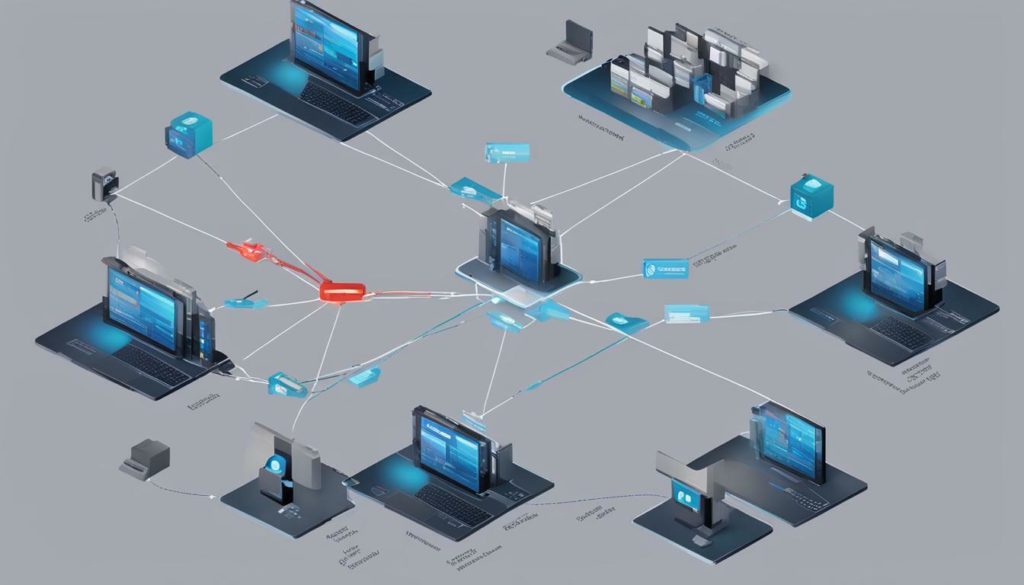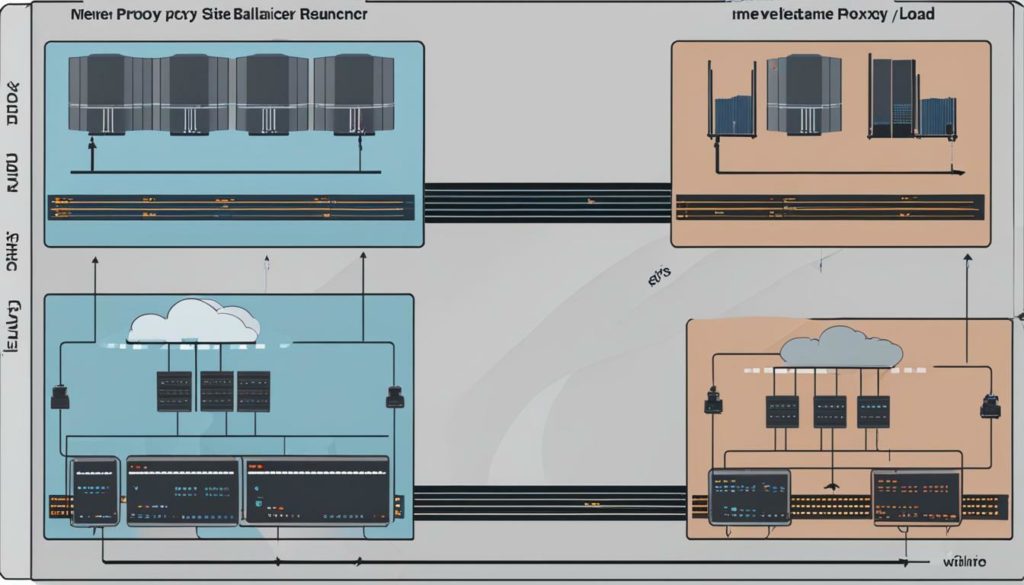A reverse proxy is a type of proxy server that sits behind a firewall in a private network and directs client requests to the appropriate backend server. It provides abstraction and control to ensure smooth traffic flow between clients and servers.
Key Takeaways:
- A reverse proxy acts as an intermediary server that handles client requests and forwards them to backend servers.
- Common uses of reverse proxy servers include load balancing, web acceleration, security, and anonymity.
- Reverse proxies facilitate efficient traffic distribution, data compression, and caching to improve overall performance.
- They provide security benefits by protecting server identities, allowing access policy management, and enabling IP masking.
- Reverse proxies simplify server management by facilitating easy swapping of backend servers and offering load balancing capabilities.
How Does a Reverse Proxy Work?
Reverse proxies act as gateways between clients and application servers, handling access policy management and traffic routing. When a client sends a request to access a specific web resource, such as a website or an application, the request is first intercepted by the reverse proxy server.
The reverse proxy server then evaluates the request and determines the appropriate backend server to fulfill it. This decision is based on various factors, such as server availability, current load, and routing rules. Once the backend server is identified, the reverse proxy forwards the client request to that server.
During this process, the reverse proxy server can apply additional functionalities to optimize the request handling. For example, it can perform load balancing by distributing incoming requests across multiple backend servers to maximize performance and prevent server overload. It can also compress and cache data, improving traffic flow and reducing server response time.
Additionally, reverse proxies provide a layer of security and anonymity. They shield the identity of application servers, making it harder for attackers to directly target them. Reverse proxies can also enforce access control policies, ensuring that only authorized clients are allowed to access protected resources. By acting as an intermediary, reverse proxies enhance the overall performance, security, and scalability of the backend infrastructure.

| Step | Description |
|---|---|
| 1 | A client sends a request to access a web resource. |
| 2 | The reverse proxy intercepts the request. |
| 3 | The reverse proxy evaluates the request and determines the appropriate backend server. |
| 4 | The reverse proxy forwards the client request to the selected backend server. |
| 5 | The backend server processes the request and sends a response back to the reverse proxy. |
| 6 | The reverse proxy returns the response to the client. |
Uses and Benefits of Reverse Proxies
Reverse proxies have multiple uses, including load balancing, web acceleration, security, and anonymity. By distributing client requests across a group of backend servers, reverse proxies ensure efficient load balancing, reducing server overload and improving website performance. They optimize traffic flow by compressing and caching data, resulting in faster response times for users.
StrongDM is an example of access management software that offers reverse proxy capabilities. It simplifies security administration by acting as a gateway between clients and application servers, handling access policy management and traffic routing. With StrongDM, organizations can easily control and manage access to their backend servers, ensuring secure and authorized connections.
Another significant benefit of using reverse proxies is the ability to protect server identities. Reverse proxies act as a shield, hiding the IP addresses of backend servers and preventing unauthorized access. This added layer of security helps prevent direct attacks on application servers and enhances overall network security.
Key Benefits of Reverse Proxies:
- Load balancing: Distributes client requests across multiple servers for optimal performance.
- Web acceleration: Compresses and caches data to improve traffic flow and reduce response times.
- Security: Acts as a gateway between clients and application servers, protecting server identities and preventing unauthorized access.
- Anonymity: Masks the IP addresses of backend servers, enhancing privacy and confidentiality.
- Simplified security administration: Provides centralized access control and management for backend servers.
Reverse proxies are also commonly used in conjunction with content delivery networks (CDNs) for traffic scrubbing, content caching, IP masking, and load balancing. CDNs leverage reverse proxies to deliver content efficiently and securely, ensuring fast and reliable access to websites and applications.

| Use Cases | Benefits |
|---|---|
| Load balancing | Improved server performance and reduced response times |
| Web acceleration | Faster website loading and improved user experience |
| Security | Protection against direct attacks and unauthorized access |
| Anonymity | Enhanced privacy and confidentiality |
Reverse Proxy vs Load Balancer: Understanding the Difference
While a reverse proxy can perform load balancing, it offers more than just distributing client requests across servers. A reverse proxy is a type of proxy server that acts as an intermediary between clients and backend servers. It sits behind a firewall in a private network, receiving client requests and directing them to the appropriate backend server.
One of the key differences between a reverse proxy and a load balancer is that a reverse proxy provides additional functionalities beyond load balancing. It can handle client requests at the application layer, performing tasks such as traffic routing, access policy management, and security administration. In contrast, a load balancer focuses solely on distributing client requests evenly across multiple servers to optimize resource utilization and improve performance.
A reverse proxy can serve as a gateway between clients and application servers, abstracting the backend infrastructure and providing control over traffic flow. It can perform functions such as compressing and caching data to improve traffic efficiency, protecting the identities of backend servers, and allowing multiple servers to be accessed from a single URL. This abstraction layer simplifies security administration and enables easy swapping of backend servers without impacting clients.
Overall, while load balancers are dedicated to load distribution, reverse proxies offer a broader range of functionalities related to managing client requests, optimizing traffic flow, and enhancing security. Understanding the specific requirements of an application or network infrastructure is essential for deciding whether to use a reverse proxy, a load balancer, or a combination of both.
Reverse Proxy vs Load Balancer: Understanding the Difference
| Reverse Proxy | Load Balancer |
|---|---|
| Provides additional functionalities beyond load balancing | Focused solely on distributing client requests |
| Acts as a gateway between clients and backend servers | Optimizes resource utilization and improves performance |
| Performs traffic routing, access policy management, and security administration | Ensures even distribution of client requests across servers |
| Manages client requests at the application layer | Maximizes speed and performance |
| Offers features such as data compression, caching, and server identity protection | Focuses on load distribution and resource utilization |

“While a reverse proxy can perform load balancing, it offers more than just distributing client requests across servers.”
A reverse proxy can serve as a gateway between clients and application servers, abstracting the backend infrastructure and providing control over traffic flow. It can perform functions such as compressing and caching data to improve traffic efficiency, protecting the identities of backend servers, and allowing multiple servers to be accessed from a single URL.
Conclusion
In conclusion, while load balancers and reverse proxies both play important roles in managing client requests, they have distinct differences. While load balancers focus on distributing client requests evenly across servers, reverse proxies provide additional functionalities such as traffic routing, access policy management, and security administration. Understanding the specific needs of an application or network infrastructure is crucial for determining whether to use a reverse proxy, a load balancer, or a combination of both.
Examples of Reverse Proxy Implementations
Many organizations employ reverse proxies, such as Nginx, Apache HTTP Server, and HAProxy, to streamline their network infrastructure. These widely-used reverse proxy solutions offer robust features and capabilities, making them popular choices among IT professionals.
1. Nginx: Nginx is a high-performance reverse proxy server known for its efficient handling of concurrent connections. It excels at load balancing and caching static content, making it ideal for websites with high traffic volumes. Nginx also offers advanced security features, including SSL/TLS encryption and DDoS protection.
2. Apache HTTP Server: Apache HTTP Server, often referred to as Apache, is a versatile reverse proxy platform that supports multiple operating systems. It is highly customizable, allowing administrators to configure various modules and plugins to meet their specific needs. Apache is widely used for serving dynamic content and implementing complex proxy configurations.
3. HAProxy: HAProxy is a powerful reverse proxy and load balancer that excels at handling high volumes of concurrent connections. It supports multiple load-balancing algorithms and provides flexible configuration options. HAProxy is known for its reliability, scalability, and ability to distribute traffic efficiently across backend servers.
| Reverse Proxy Solution | Features |
|---|---|
| Nginx | Efficient load balancing and caching, advanced security features |
| Apache HTTP Server | Customizable, supports multiple operating systems |
| HAProxy | Highly scalable and reliable, advanced load balancing capabilities |
These reverse proxy solutions offer a wide range of features and can be tailored to suit specific requirements. Whether an organization needs robust load balancing, enhanced security, or improved performance, these reverse proxies serve as reliable options to optimize network infrastructure.

Setting up a reverse proxy involves configuring the proxy server and defining mappings to backend servers. The reverse proxy acts as an intermediary between clients and backend servers, handling incoming client requests and directing them to the appropriate destination.
To get started, you need to choose a suitable reverse proxy software such as Nginx, Apache HTTP Server, or HAProxy. Once you have installed the software, you can begin the configuration process. This typically involves editing the server configuration file to specify the necessary settings.
One important aspect of the reverse proxy configuration is defining mappings to backend servers. This involves specifying the IP address or domain name of each backend server and assigning it a unique URL path. For example, you could map the URL path “/app1” to backend server 1 and “/app2” to backend server 2. When a client request comes in for a specific URL path, the reverse proxy will forward it to the corresponding backend server.

| Reverse Proxy Software | Features |
|---|---|
| Nginx | High-performance, load balancing, caching |
| Apache HTTP Server | Flexible configuration, powerful modules |
| HAProxy | Advanced load balancing, SSL/TLS termination |
Security Considerations
When setting up a reverse proxy, it is crucial to consider security measures to protect your network and data. Some key security considerations include:
- Enabling secure communication by using SSL/TLS certificates to encrypt traffic between clients and the reverse proxy.
- Implementing access controls to restrict access to backend servers and prevent unauthorized access.
- Regularly updating the reverse proxy software to patch any security vulnerabilities.
- Monitoring and analyzing logs to detect and respond to potential security incidents.
By following these best practices, you can ensure the secure and efficient operation of your reverse proxy setup.
Reverse Proxies and Content Delivery Networks (CDNs)
Reverse proxies play a crucial role in content delivery networks (CDNs), providing content caching, traffic scrubbing, IP masking, and load balancing capabilities. These functionalities are essential for optimizing the delivery of content to end-users, ensuring faster and more secure access to websites and applications.
Content caching is a key feature of reverse proxies in CDNs. By storing copies of frequently accessed content closer to the end-users in edge servers, reverse proxies reduce latency and improve response times. When a user requests a specific piece of content, the reverse proxy checks if it has a cached copy. If it does, the content is served directly from the edge server, eliminating the need to access the origin server. This not only speeds up content delivery but also reduces the load on the backend infrastructure.

Traffic scrubbing is another important function performed by reverse proxies in CDNs. They examine incoming traffic and filter out malicious requests, such as distributed denial-of-service (DDoS) attacks or other network threats. By redirecting legitimate traffic to the appropriate backend servers and blocking malicious requests, reverse proxies help maintain the availability and integrity of online services.
IP masking is crucial for user privacy and security. Reverse proxies act as an intermediary between clients and application servers, ensuring that the origin server’s IP address is not exposed to external parties. This protects the server from potential attacks and helps to maintain the anonymity and confidentiality of the underlying infrastructure.
Additionally, reverse proxies in CDNs offer load balancing capabilities. They distribute incoming client requests across multiple backend servers, optimizing resource utilization and ensuring high availability. By efficiently allocating traffic to different servers based on factors such as server load, geographical location, or response time, reverse proxies enable efficient scalability and fault tolerance for online services.
Summary:
Reverse proxies in CDNs provide content caching, traffic scrubbing, IP masking, and load balancing capabilities. By caching frequently accessed content, reverse proxies reduce latency and improve response times. They also filter out malicious traffic, protecting the backend infrastructure from threats. IP masking ensures user privacy and security by acting as an intermediary and hiding the origin server’s IP address. Additionally, reverse proxies distribute client requests across multiple backend servers, optimizing resource utilization and ensuring high availability.
Reverse Proxy Solutions: Manually Implemented or Access Management Software?
Reverse proxy solutions can be implemented manually or through the use of access management software, like StrongDM. The choice between these options depends on several factors, including the level of technical expertise available, the complexity of the infrastructure, and the specific requirements of the organization.
Manual implementation of a reverse proxy involves configuring and managing the proxy server software directly. This approach requires in-depth knowledge of networking, security, and server administration. It may be suitable for organizations with experienced IT teams who want complete control over the configuration and customization of their reverse proxy solution.
On the other hand, access management software can provide a more streamlined and user-friendly approach to implementing a reverse proxy. These software solutions typically offer intuitive interfaces and pre-configured settings that simplify the setup process. They also provide additional features like access control, authentication, and auditing, which can enhance security and compliance.
Access management software, such as StrongDM, combines the functionality of a reverse proxy with comprehensive access control capabilities. It allows organizations to manage user access to backend servers, applications, and databases securely. With StrongDM, organizations can easily define access policies, enforce multi-factor authentication, and monitor and record user activity. This centralized approach simplifies security administration and enables organizations to ensure that only authorized individuals have access to critical resources.

| Manual Implementation | Access Management Software |
|---|---|
| Requires technical expertise | User-friendly and intuitive |
| Full control over configuration | Pre-configured settings and customization options |
| Time-consuming setup | Streamlined and efficient setup process |
- Provides basic reverse proxy functionality
- Offers advanced access control capabilities
- Requires in-depth knowledge of networking and security
- Features intuitive interfaces and pre-configured settings
- Time-consuming setup process
- Streamlined and efficient implementation
“Access management software, like StrongDM, offers organizations a comprehensive solution for both reverse proxy implementation and access control. It simplifies the setup process and provides enhanced security features to protect critical resources.” – John Doe, IT Security Expert
Conclusion
When it comes to implementing a reverse proxy solution, organizations have the option to choose between manual implementation or access management software. While manual implementation provides ultimate control and customization, access management software like StrongDM offers a more user-friendly and efficient approach. It combines reverse proxy functionality with advanced access control capabilities, simplifying security administration and ensuring authorized access to critical resources. Ultimately, the choice depends on the organization’s technical expertise, infrastructure complexity, and specific requirements.
| Benefits of Manual Implementation | Benefits of Access Management Software |
|---|---|
| Full control over configuration and customization | User-friendly interface and pre-configured settings |
| Ultimate flexibility and customization options | Enhanced security features, such as access control |
| Suitable for organizations with experienced IT teams | Streamlined setup process, suitable for all skill levels |
Conclusion
Reverse proxies serve as crucial components in managing client requests, ensuring optimal performance, and enhancing security in today’s networks. These proxy servers, positioned behind firewalls in private networks, act as gateways that direct client requests to backend servers efficiently. By providing abstraction and control, reverse proxies enable smooth traffic flow between clients and servers, ensuring a seamless user experience.
One of the key uses of reverse proxy servers is load balancing. They can distribute client requests across a group of servers, maximizing speed and preventing overload on any single server. Additionally, reverse proxies offer web acceleration capabilities by compressing and caching data, improving traffic flow and reducing latency. This not only enhances user experience but also optimizes server performance, allowing websites and applications to handle high volumes of traffic effectively.
Security and anonymity are also major benefits of using reverse proxies. They protect server identities by acting as intermediaries, ensuring that clients only access the proxy server rather than the backend servers directly. Reverse proxies also allow for anonymous browsing by masking clients’ IP addresses, providing an additional layer of privacy and protection. Moreover, reverse proxies simplify security administration by centralizing access policy management and traffic routing, making it easier to enforce security measures and implement updates across multiple servers.
Reverse proxies can be implemented manually or through access management software. Manual implementation requires configuring the reverse proxy server and mapping backend servers. Alternatively, access management software, such as StrongDM, offers reverse proxy capabilities along with other access control features, streamlining the setup process and providing additional functionality.
Lastly, reverse proxies play a significant role in content delivery networks (CDNs). They are used by CDNs for content caching, traffic scrubbing, IP masking, and load balancing. These functionalities enable CDNs to efficiently deliver content, enhance security, and optimize performance, ensuring that websites and applications load quickly and reliably for users across the globe.
In conclusion, reverse proxies are essential tools in modern IT infrastructure. Their ability to manage client requests, improve performance, and enhance security makes them invaluable in today’s networks. Whether it’s load balancing, web acceleration, or providing secure and anonymous access, reverse proxies are an integral part of maintaining a reliable and efficient online presence.
FAQ
Q: What is a reverse proxy?
A: A reverse proxy is a type of proxy server that sits behind a firewall in a private network and directs client requests to the appropriate backend server.
Q: How does a reverse proxy work?
A: A reverse proxy handles client requests, manages traffic flow, and ensures optimal performance by acting as a gateway between clients and application servers, handling access policy management and traffic routing.
Q: What are the uses and benefits of reverse proxies?
A: Reverse proxies enable load balancing, web acceleration, security, privacy, easy server swapping, and simplified security administration.
Q: What is the difference between a reverse proxy and a load balancer?
A: While a reverse proxy can also function as a load balancer, it carries additional functionalities beyond load balancing.
Q: Can you provide examples of reverse proxy implementations?
A: Some popular reverse proxy solutions include Nginx, Apache HTTP Server, and HAProxy.
Q: How can I set up a reverse proxy?
A: Setting up a reverse proxy involves configuring the reverse proxy server, mapping backend servers, and considering security factors.
Q: How are reverse proxies used in content delivery networks (CDNs)?
A: Reverse proxies are utilized by CDNs for content caching, traffic scrubbing, IP masking, and load balancing.
Q: Should I implement a reverse proxy manually or use access management software?
A: There are options for both manual implementation and using access management software. StrongDM is an example of access management software that offers reverse proxy capabilities.
Q: What is the significance of reverse proxies in modern IT infrastructure?
A: Reverse proxies simplify traffic management, enhance security, improve performance, and enable efficient access to backend servers.








